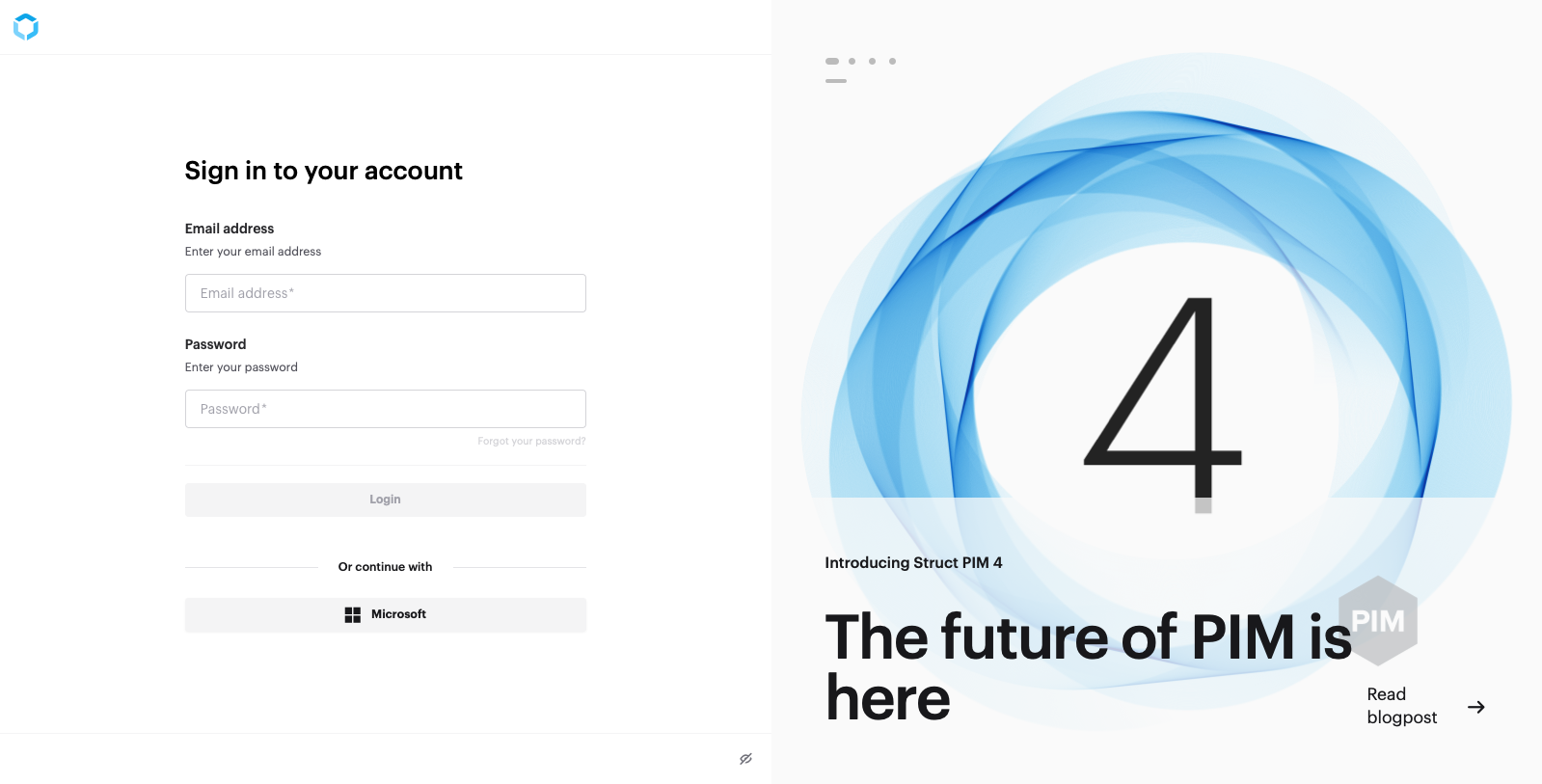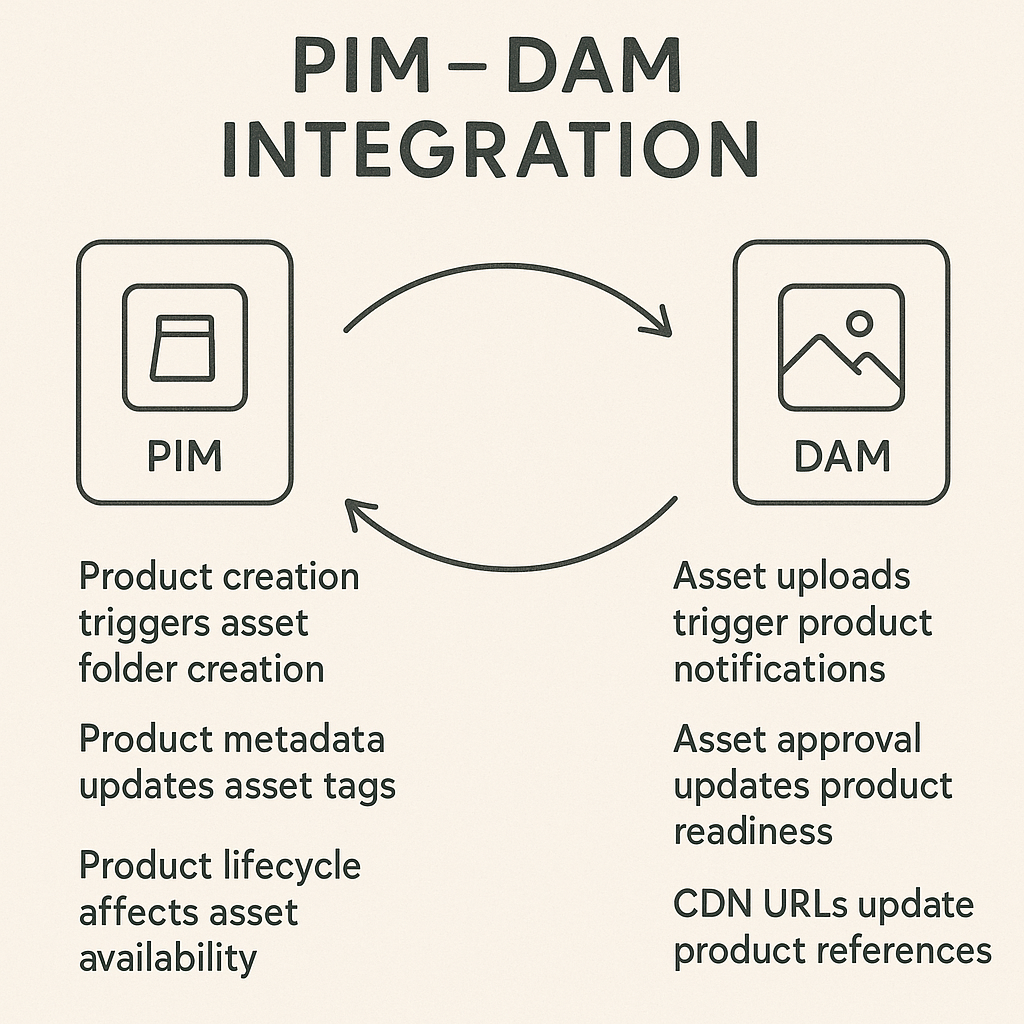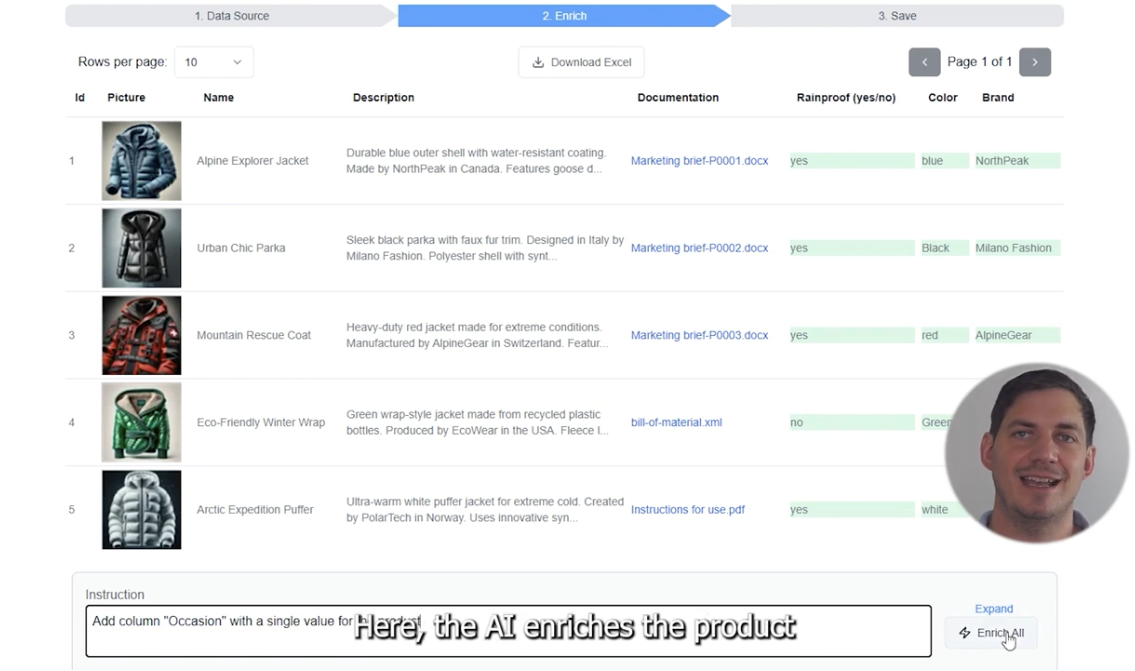Platform Oversigt
Struct PIM lægger vægt på konfigurerbare produktmodeller der kan repræsentere produkt/variant hierarkier med fleksibel attribut scoping. Grundlagt i Danmark leverer Struct en cloud-native løsning hostet på Microsoft Azure med stærk nordisk markedstilstedeværelse og fokus på detail/engros scenarier.
Platformens Product Structure system fungerer som en blueprint der beskriver faner, sektioner og attributter der udgør Produkter og Varianter. Denne konfigurerbare tilgang giver virksomheder mulighed for at modellere komplekse produkthierarkier mens de opretholder datakonsistens gennem Business Rules og Enrichment Insights.
Nøglefakta
- Grundlagt: 2010erne
- Hovedkontor: Danmark
- Infrastruktur: Microsoft Azure cloud-native
- API: REST med omfattende Swagger dokumentation
- Implementering: Single-tenant SaaS containere

Struct PIM login side interface
Struct login interfacet demonstrerer den rene, moderne designtilgang af denne Azure-hostede PIM platform.
Kerneentiteter i Structs konfigurerbare datamodel med fleksible produktstrukturer og relationer
| Entity | Vendor Name | Description | Key Attributes | Relationships |
|---|---|---|---|---|
Produktstruktur | Product Structure | Blueprint der beskriver faner, sektioner og attributter som udgør Produkter og Varianter | tab definitioner sektion layout attribut konfiguration | definerer Product schema konfigurerer Variant struktur |
Produkt | Product | Salgbar SKU der kan være simpel eller del af Variant Groups med konfigurerbare attributter | struktur-definerede felter lokaliserede værdier segmenterede data | følger Produktstruktur medlem af Variant Group kategoriseret i Kataloger |
Variant | Variant | Niveau under Produkt når variationer som størrelse/farve er nødvendige | variant attributter nedarvede værdier override data | barn af Produkt medlem af Variant Group |
Variant Group | Variant Group | Logisk bundle af varianter; nyttigt til 3-niveau variant sæt | gruppe konfiguration variant relationer delte attributter | indeholder Varianter organiserer produkthierarki |
Global Liste | Global List | Genbrugelig liste af nøgle-værdi par med komplekse sub-attributter til custom entiteter | liste elementer komplekse attributter sub-attribut struktur | brugt af liste attributter leverer kontrollerede vokabularer |
Katalog | Catalogue | Sortimentstræ der mapper produkter til kanaler med kanal-specifikke attribut scoping | kanal mapping attribut scope kategori struktur | indeholder Kategorier afgrænser Produkt attributter |
Ny til PIM systemer?
Før du dykker ned i Struct specifika, bør du måske læse vores omfattende guide til PIM systemer for at forstå det grundlæggende og nøglekoncepter.
Læs PIM Systemer GuidePlatform Demo & Interface
Se denne omfattende demo der viser Struct PIM og dækker de grundlæggende brugeraktiviteter: find produkter, berig produkter, merchandising produkter og publicer produkter. Optaget på et cloud-hostet Struct 3 miljø i januar 2023.
Demoen fremhæver Structs konfigurerbare produktstrukturer og det fleksible attribut scoping system der understøtter lokalisering og markedssegmentering.
"Jeg kan virkelig godt lide produktoversigten der typisk har flere faner og sektioner. Relaterede entiteter og attributværdier blander sig sammen på en fantastisk måde, hvilket giver fremragende brugeroplevelse."
Komplet liste over attributtyper tilgængelige i Struct med lokalisering og segmenteringskapabiliteter
| Common Name | Vendor Name | Description | Operators | Examples |
|---|---|---|---|---|
Tekst | Text | Tekstfelter med varierende længde og formateringskapabiliteter | Equals NotEquals Contains StartsWith IsNull NotNull | Produktnavn Beskrivelse SKU |
Nummer | Number | Numeriske felter inklusiv valuta-specifik formatering | Equals NotEquals GreaterThan LessThan Between IsNull NotNull | Pris Vægt Kvantitet |
Boolean | Boolean | Sand/falsk checkbox felt | Equals (true/false) IsNull NotNull | Er aktiv Fremhævet Udgået |
Dato | Date | Dato og datetime felter | Equals NotEquals GreaterThan LessThan Between IsNull NotNull | Lancering dato Sidst modificeret Udløbsdato |
Single Select | GlobalListValue | Enkelt valgmulighed fra Global List | Equals NotEquals In NotIn IsNull NotNull | Brand Kategori Status |
Multi Select | GlobalListValue (multivalue) | Flere valgmuligheder fra Global List | In NotIn IsNull NotNull | Features Materialer Certificeringer |
Asset Reference | Media | Referencer til assets med sikker lagring og direkte produkt associationer | IsNull NotNull | Produktbilleder Videoer Dokumenter |
Entitetsreference | ProductReference, VariantReference, CategoryReference, AttributeReference, CollectionReference | Referencer til andre produkter, varianter, kategorier, eller andre entiteter inden for systemet | Equals NotEquals In NotIn IsNull NotNull | Relaterede produkter Kryds-sælgs produkter Ersætter produkter |
Collection | TagCollection | String array til tag-baseret kategorisering | Contains NotContains IsNull NotNull | Tags Nøgleord Labels |
Complex Object | ComplexAttribute | Strukturerede data containere med konfigurbare sub-attributter. API v4 kræver komplette attribut definitioner som SubAttributter, ikke referencer. | IsNull NotNull | Tekniske specifikationer Fysiske dimensioner (L×B×H) Produkt certificeringer med datoer |
List | List | En liste af værdier, hvor hver værdi er defineret af en skabelon-attribut. | IsNull NotNull | Komponentlister Ingredienslister |
"Centralt for Struct er produktlisten med mange attributtyper og arv. Custom records modelleres som Global Lists. At sætte op Global Lists baseret på komplekse attributtyper giver næsten de samme modelleringskapabiliteter på custom records som på produkter."
API Implementering Detaljer
Autentificering & Sikkerhed
Struct bruger API nøgle autentificering med X-Api-Key header. Nøgler er scopet til granulære endpoint tilladelser, hvilket giver finkornede adgangskontrol for forskellige integrationsscenarier.
Søgning & Filtrering
POST /api/search endpoint accepterer JSON Query DSL der kombinerer Filters og Expressions. Fuldtekstsøgning understøttes via /api/search/fulltext, hvilket muliggør omfattende produkt discovery kapabiliteter.
Lokalisering & Segmentering
Attributværdier kan scoperes efter Language, Market (Channel) og Dimension kontekster defineret af Attribute Scope. Dette giver kraftfuld multi-marked og multi-sprog support uden data duplikation.
Business Rules Engine
No-code regel engine automatiserer værdi beregning, validering og workflow triggers. Dette muliggør kompleks business logik implementering uden custom udvikling.
Webhooks & Synkron Event Arkitektur
Webhooks kan oprettes via Settings → Webhooks eller POST /api/webhooks. Events leveres med HMAC signaturer for sikkerhed. Vigtigt er det at Struct sender webhook events i samme "batch" som den oprindelige operation - hvis du bulk opdaterer 25 produkter, modtager du én webhook event der indeholder alle 25 produkter. Dette adskiller sig fra de fleste PIM systemer der udsender individuelle events per entitetsændring gennem separate event lag. Denne synkrone tilgang betyder at når middleware caching implementeres (hvilket anbefales for performance), kan events have behov for at blive routet omkring Struct helt for at vedligeholde real-time data konsistens, da webhook timing er bundet direkte til API operation flowet.
API brug eksempel
Eksempel der viser hvordan man opdaterer et produkt ved brug af Structs REST API med PowerShell
# Update product name using Struct PIM API
$apikey = "<api_key>"
$body = @(
@{ id = 98765; attributes = @{ Name = @{ en = "New product title 2025" } } }
) | ConvertTo-Json
Invoke-RestMethod -Uri "https://acme.struct.com/api/products" `
-Method Patch `
-Headers @{"x-api-key"=$apikey; "Content-Type"="application/json"} `
-Body $bodyAPI Søgeeksempel: Find Produkt via Attribut
Eksempel der viser hvordan man søger efter produkter via en specifik attributværdi ved hjælp af Structs Search API og JSON Query DSL.
# Søg efter produkter ved hjælp af Struct PIM API
$apikey = "<api_key>"
$searchBody = @{
Query = @{
Expressions = @(
@{
FieldName = "sku"
Operator = "Equals"
Value = "SKU-12345"
}
)
}
} | ConvertTo-Json -Depth 5
Invoke-RestMethod -Uri "https://acme.struct.com/api/search" `
-Method Post `
-Headers @{"x-api-key"=$apikey; "Content-Type"="application/json"} `
-Body $searchBodyComplex Attributes API v4: Implementerings Virkelighed
API Schema vs Virkelighed
Når man arbejder med Complex Attributes i Struct API v4, adskiller den faktiske implementering sig markant fra Swagger dokumentationen. Vores empiriske tests afslørede at SubAttributes skal være komplette attribut definitioner, ikke bare referencer som foreslået i dokumentationen.
Vigtige V4 Læringer
- Komplette SubAttribute Definitioner Påkrævet: Hver SubAttribute har behov for alle basis egenskaber (Uid, Alias, BackofficeName, AttributeType, etc.)
- Ingen Reference-Baseret Tilgang: I modsætning til hvad dokumentationen foreslår, kan du ikke referere til eksisterende attributter
- TypeScript Casting Nødvendig: API'et er mere fleksibelt end type definitioner antyder
- Batch Operations Support: Complex Attributes fungerer godt med bulk endpoints til håndtering af store datasæt
- 🆕 Globale Lister Understøtter Komplekse Attributter: Udokumenteret funktion - Globale Lister KAN bruge Komplekse Attributter til rige, strukturerede referencedata!
For detaljerede implementerings eksempler, fejlfinding og praktiske kode eksempler inklusiv den nye Globale Lister opdagelse, se vores omfattende Struct PIM API v4 Complex Attributes Tutorial.
Strategiske overvejelser for Struct implementering inkluderende Azure-hostet infrastruktur, nordisk markedsfokus og platformsbeslutninger
Tekniske Specifikationer
Azure-Native Arkitektur
Hostet på Microsoft Azure med single-tenant containere der giver enterprise-grade sikkerhed og performance. Multi-region deployment muligheder tilgængelige for globale organisationer.
Built-in Import Funktionalitet
Omfattende import kapabiliteter der understøtter CSV og Excel formater med data validering, fejlhåndtering og batch processing. Inkluderer import skabeloner og felt mapping til effektiv produktdata management.
Built-in Media Archive
Media attribut funktionalitet til håndtering af produkt-relaterede assets med sikker fil lagring og direkte produkt associationer. Avancerede funktioner som dynamisk resizing og CDN integration tilgængelige gennem eksterne services.
Kategori-Niveau Attributter
Systemet understøtter opsætning af attributter på kategorier i master kataloget, som skal være tilgængelige for alle produkter klassificeret inden for den kategori. Når produkter er i flere kategorier, definerer den primære kategori tilgængelige attributter.
Segmentering og Dimensioner
Avanceret kontekst-baseret attribut scoping efter kanal, marked eller brugersegment muliggør sofistikerede kanal-specifikke produktvisninger og skræddersyet indhold præsentation.
Native Task Management
Built-in Task funktionalitet til workflow koordination med bruger tildeling, fremskridt sporing og notifikationer for indhold godkendelsesprocesser.
AI Assistant
Built-in AI Assistant funktionalitet der giver intelligente data berigelse kapabiliteter, produktbeskrivelse forslag og indhold anbefalinger baseret på eksisterende produktdata.
Publikations Planlægning
Native publikations planlægnings funktioner tillader produkter at blive konfigureret med publikations start/slut datoer for automatiseret livscyklus management og sæson kampagner.
Enrichment Insights
Regelbaseret scoring system leverer fuldstændighedsprocenter (0-100%) per produkt, variant og katalog. Export kapabiliteter understøtter CSV og Excel formater nativt.
Bulk Operationer
Bulk opdateringer gennem /api/products/bulk og /api/variants/bulk endpoints understøtter op til 5.000 entiteter per kald, hvilket muliggør effektiv storskala data management. Complex Attributes understøttes fuldt ud i disse bulk operationer, hvilket muliggør effektiv håndtering af strukturerede produktspecifikationer og tekniske data i stor skala.
"Som nævnt i deres dokumentation: 'API'et er bygget til at opdatere og læse store mængder data på kort tid med udvidet support til batching.' Dog anbefaler de ikke at bruge API'et som direkte kilde til præsentation. I min erfaring er der virkelig ingen måde at sætte Struct op uden middleware til performance optimering."
Begrænsninger & Implementeringsovervejelser
API Performance Krav
Selvom Struct giver omfattende REST API kapabiliteter, anbefaler platformen eksplicit mod at bruge API'et som direkte kilde til præsentationslag. De fleste virkelige implementeringer kræver middleware til performance optimering, hvilket tilføjer arkitektonisk kompleksitet og udviklingsomkostninger.
Bulk Operation Begrænsninger
5.000 entitets grænsen per bulk operation kan hindre store katalog management scenarier. Organisationer med omfattende produktkataloger kan have brug for at implementere komplekse batching strategier for effektive dataoperationer.
Nordisk Markedsfokus
Stærk nordisk markedstilstedeværelse kan begrænse globale funktionsudviklingsprioriteter. Organisationer uden for den nordiske region bør evaluere om platformens roadmap stemmer overens med deres specifikke markedskrav og compliance behov.
Ingen Native Valuta/Pris Attribut
Mangel på dedikerede valuta eller pris attributtyper kræver brugerdefinerede modelleringstilgange til finansielle data, hvilket potentielt komplicerer prissætningsworkflows og multi-valuta scenarier.
Azure Afhængighed
Single-tenant Azure hosting giver sikkerhedsfordele men begrænser deployment fleksibilitet. Organisationer der kræver on-premises deployment eller alternative cloud udbydere har ingen muligheder.
Kommercielle Overvejelser
Selvom prissætning transparens værdsættes, kan den forbrugsbaserede model blive dyr for høj-volumen scenarier. For detaljerede prissætningsstrategier og forhandlingstilgange, se vores omfattende SaaS forhandlingsguide.
Structs Azure-native arkitektur gør det perfekt til AI indhold workflows deployed på Microsoft Azure.
Nøglefordele & Styrker
Product Structure Fleksibilitet
Product Structures fungerer som dynamiske blueprints der definerer attributgrupper, påkrævede felter og valideringsregler. Dette muliggør at forskellige produkttyper kan have skræddersyede datamodeller mens konsistens vedligeholdes inden for kategorier. Kategori-niveau attributter sikrer delte krav på tværs af produktklassifikationer.
Azure-Native Arkitektur
Bygget specifikt til Microsoft Azure med native integration til Azure services. Dette giver enterprise-grade sikkerhed, compliance kapabiliteter og sømløs integration med Microsoft business applikationer.
Avanceret Segmentering
Segmentering og Dimensioner muliggør sofistikerede kanal-specifikke visninger med kontekst-baseret attribut scoping efter kanal, marked eller brugersegment for optimal indhold præsentation.
Built-in AI Kapabiliteter
Native AI Assistant giver intelligent data berigelse, produktbeskrivelse forslag og indhold anbefalinger direkte inden for platformen uden eksterne integrationer.
Omfattende Import Værktøjer
Built-in Import funktionalitet med CSV og Excel support, data validering, fejlhåndtering og batch processing strømliner data management workflows.
Global Lists til Master Data
Global Lists (brands, leverandører, kategorier) giver centraliseret master data management med hierarkiske strukturer. Disse lister understøtter komplekse business regler og kan deles på tværs af flere produktstrukturer.
Intuitiv Brugeroplevelse
Rent, moderne interface designet til business brugere snarere end tekniske administratorer. Det konfigurerbare dashboard og simplificerede navigation reducerer træningskrav og forbedrer brugeradoption.
Transparent Prismodel
Alle priser tilgængelige på hjemmeside.
Stærkt API Fundament
Omfattende REST API med bulk operationer support, selvom API performance kan kræve middleware lag til høj-volumen præsentationslag integrationer. Godt til back-office integration scenarier.
Sivert Kjøller Bertelsen
PIM Implementerings Konsulent • Flere Struct implementeringer
"Struct udmærker sig ved at give et rent, intuitivt produktoverblik med fremragende attributorganisering. Global Lists tilgangen til custom entities er klog, og den Azure-native arkitektur sikrer solid performance. Dog betyder API performance begrænsningerne at du har brug for middleware til de fleste virkelige scenarier. Platformen rammer en god balance mellem funktionalitet og brugervenlighed for mid-market organisationer."





